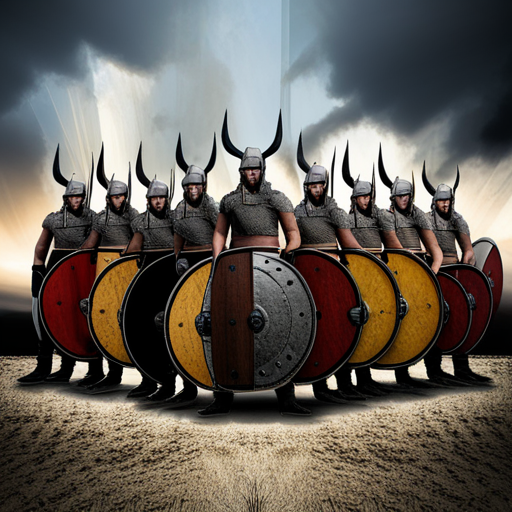As a history enthusiast, I’ve always been fascinated by the Vikings and their legendary battles. One of the most iconic and effective formations used by the Vikings was the Shield Wall. This formation was not only an impressive display of military tactics, but it also showcased the unity and strength of the Viking warriors.
The Shield Wall was a formation where warriors would stand shoulder-to-shoulder, with their shields overlapping and their spears pointing outwards. This formation was used to protect the warriors from enemy attacks and to push forward as a single unit.
In this article, we’ll explore the origins of the Shield Wall, its anatomy, key tactics for effective formation, and examine examples of the Shield Wall in action from Viking history. We’ll also discuss how the Shield Wall has influenced modern warfare tactics.
So, let’s dive in and unleash the power of the Shield Wall!
The Origins of the Shield Wall
As we delve into the history of this defensive strategy, imagine warriors standing shoulder to shoulder, their interlocked shields forming an impenetrable barrier against their enemies.
The Shield Wall was an iconic formation used mainly by Viking warriors during battles. It was a defensive strategy that helped them overcome larger armies and emerge victorious in many battles.
The Shield Wall formation was created to maximize the strength of Viking warriors. These warriors were known for their physical strength, and the Shield Wall formation gave them the opportunity to showcase it.
The warriors stood shoulder to shoulder and interlocked their shields, creating a barrier that was nearly impossible to penetrate. The formation was not only a defensive strategy, but it also gave the warriors the chance to move forward as one unit, pushing their enemies back and gaining ground.
In the next section, we will look at the anatomy of the Shield Wall and how it was executed during battles.
Anatomy of the Shield Wall
Let’s take a closer look at how the warriors of the North crafted their impenetrable defense in the midst of battle. The Shield Wall is the most common battle formation used by the Vikings. It’s a tightly packed formation that involves the warriors standing shoulder to shoulder, with their shields overlapping one another.
The Shield Wall was designed to allow the warriors to withstand the enemy’s attack and to create a barrier that was almost impossible to penetrate. Here are some key features of the Shield Wall that made it so effective:
– The warriors stood shoulder to shoulder, creating a solid barrier that was almost impossible to penetrate.
– The shields were overlapped, which meant that there were no gaps in the formation that the enemy could exploit.
– The warriors in the front row held their shields at an angle, providing extra protection for themselves and the warriors behind them.
As you can see, the Shield Wall was a formidable defense mechanism that allowed the Vikings to withstand even the most ferocious attacks. But how did they use this formation to their advantage? In the next section, we’ll take a closer look at some of the key tactics used in Shield Wall formation.
Key Tactics for Effective Shield Wall Formation
Get ready to learn some of the most effective tactics used by the North’s warriors when utilizing their impenetrable defense formation, the Shield Wall.
The key to the Shield Wall’s effectiveness was the formation’s ability to create a solid barrier that was nearly impossible to penetrate. To achieve this, the warriors would line up shoulder to shoulder, holding their shields tightly together to form a continuous wall of protection.
One of the most important tactics for the Shield Wall was the ‘skeletal’ formation. This involved creating spaces in the wall that allowed the warriors to strike at the enemy with their weapons while still maintaining a solid defense.
By leaving gaps in the formation, the warriors could thrust their spears, swing their axes, and fire arrows at the enemy, all while being protected by their comrades’ shields.
Another tactic was to have the front lines kneel or crouch down, while the second line stood behind them, thrusting their spears over their comrades’ heads. This provided an additional layer of protection and created a more effective barrier against enemy attacks.
With these tactics in mind, the Shield Wall was an unstoppable force on the battlefield.
In the next section, we’ll take a look at some examples from Viking history to see the Shield Wall in action.

The Shield Wall in Action: Examples from Viking History
Witnessing the Shield Wall in its full glory is like watching a majestic symphony of warriors moving in perfect harmony, creating an impenetrable fortress of defense that strikes fear into the hearts of their enemies.
One of the most famous examples of the Shield Wall in action was during the Battle of Stamford Bridge in 1066, where King Harold Godwinson led his army against the invading Norwegian forces of Harald Hardrada.
The Viking army attempted to break the English Shield Wall but failed, and the English were able to hold their ground and ultimately win the battle.
Another example of the Shield Wall in action was during the Battle of Hastings later that same year, where King Harold Godwinson faced off against William the Conqueror.
Despite his previous victory at Stamford Bridge, Harold’s army was unable to maintain their Shield Wall formation and were eventually defeated.
These battles highlight the importance of not only forming the Shield Wall but also maintaining it throughout the battle, as a successful Shield Wall can mean the difference between victory and defeat.
Legacy of the Shield Wall: Influence on Modern Warfare Tactics
The Shield Wall’s impact on modern warfare tactics cannot be underestimated, as its principles and strategies have been adapted and implemented by armies throughout history.
The concept of forming a solid wall of shields to protect and advance as a cohesive unit has become a staple in military strategy. In fact, many of the tactics used by the Romans, Greeks, and even modern armies like the US Marines, have roots in the Viking Shield Wall.
One of the key principles that has been adopted from the Shield Wall is the importance of unit cohesion. Just like the Vikings, modern armies understand that a unit that fights together, stays together.
This means that soldiers are trained to move and fight as one unit, staying close together to provide mutual protection and support. This principle has been incorporated into modern military training and tactics, and has proven to be effective in achieving victory on the battlefield.
The Shield Wall may have been developed over a thousand years ago, but its legacy lives on in modern warfare.
Frequently Asked Questions
What types of weapons did Vikings use in battle besides shields?
When it comes to Viking weapons in battle, the most well-known tools of the trade were axes and swords. However, spears were actually the most common weapon used by Vikings due to their versatility and reach. In fact, over 80% of Viking weapons found in archaeological digs are spears.
But don’t underestimate the power of a Viking bow and arrow or their throwing weapons like javelins and throwing axes. These weapons allowed for ranged attacks and strategic surprise attacks.
So while shields were crucial to the iconic shield wall, Vikings had a variety of weapons at their disposal to dominate the battlefield.
Were there any other battle formations commonly used by Vikings besides the shield wall?
I’m sure you’re curious to know if there were any other battle formations commonly used by Vikings besides the shield wall.
Well, there were! One such formation was the ‘swine array,’ where warriors formed a wedge-shaped formation with the strongest and most experienced fighters at the front.
Another formation was the ‘skein,’ where warriors formed a line of interlocking shields and spears to create a wall of defense. These formations were used strategically depending on the terrain and the enemy they were facing.
It’s fascinating to see how Vikings utilized different tactics to gain an advantage in battle.
What kind of training did Viking warriors undergo to become proficient in the shield wall formation?
When it comes to the shield wall formation, Viking warriors underwent rigorous training to become proficient in its execution. It was like a dance, with each warrior moving in sync with the others, their shields forming an impenetrable wall.
Training included exercises to improve strength, endurance, and coordination, as well as drills that allowed warriors to practice moving as one. Our trainers would often say that the shield wall was like a living organism, with each warrior being a vital part of its overall function.
It was a truly awe-inspiring sight to see it in action, and being a part of it made me feel like I belonged to something greater than myself.
How did Viking commanders decide on the positioning of warriors within the shield wall?
When I was a Viking commander, deciding on the positioning of warriors within the shield wall was crucial for victory in battle.
I would assess the terrain, the enemy’s tactics, and the strengths and weaknesses of my own troops.
I would place the strongest and most experienced warriors in the center of the shield wall, with newer and less experienced warriors on the flanks. This allowed the center to hold strong while the flanks could maneuver and adapt to changing circumstances.
It was also important to have skilled archers and spearmen positioned strategically behind the shield wall to provide cover and support.
With the right positioning and coordination, we could unleash the power of the shield wall and emerge victorious.
Did Vikings ever face any defeats or challenges while using the shield wall formation in battle?
I’ve always been fascinated by the Viking shield wall formation and how it must have been a sight to behold on the battlefield. However, it’s interesting to note that despite the reputation the Vikings have for being fearsome warriors, they did face some defeats and challenges while using the shield wall.
In fact, during the Battle of Stamford Bridge in 1066, the English army broke through the shield wall of the Viking army and ultimately won the battle.
This just goes to show that even the most effective battle formations can be overcome with the right strategy and determination from the opposing army.
Conclusion
In conclusion, the Shield Wall was an effective and powerful battle formation utilized by the Vikings. Its origins can be traced back to the early days of Viking raids, and it evolved into a formidable tactic that allowed the warriors to hold their ground against larger and better-equipped armies.
The key to the success of the Shield Wall was its discipline and coordination. The Vikings were able to work together to create an impenetrable barrier that kept their enemies at bay.
This formation was so effective that it influenced modern warfare tactics and is still studied and used today.
So, if you ever find yourself in a battle, remember the power of the Shield Wall. It may just be the difference between victory and defeat.





